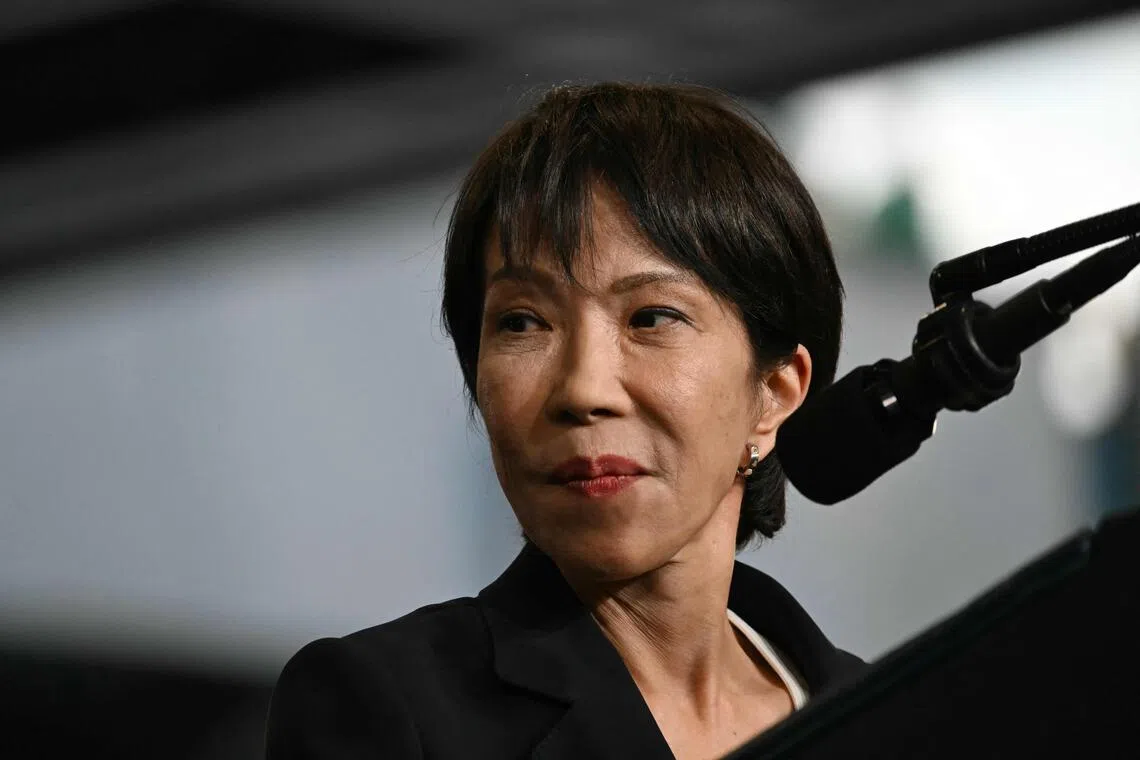Chinese and Japanese leaders meet to talk about rare earths, security
Sign up now: Get insights on Asia's fast-moving developments

Japan's Prime Minister Sanae Takaichi said she raised her concerns over Japan's rare earth export restrictions.
PHOTO: AFP
Follow topic:
Japan’s new Prime Minister Sanae Takaichi told China’s President Xi Jinping her concerns over his country’s rare earth export restrictions in their first formal meeting, as tensions spanning from trade to security continue to simmer between the two countries.
“I said that there’s no denying that there are pending issues and differences in opinion, and that is why it is important for us to hold direct and candid talks,” Ms Takaichi told reporters after the meeting on Oct 31 on the sidelines of the Apec conference.
China is Japan’s largest trading partner while the US provides Tokyo with crucial security guarantees, which forces Japan into an awkward balancing act when China and the US are increasingly at loggerheads.
A number of bilateral issues also continue to simmer, including China’s increasing military activity around a disputed cluster of islands, trade restrictions, as well as concerns over maintaining peace and stability in the Taiwan Strait.
While curbs on the export of critical minerals were put in place as leverage in the trade war between China and the US, the slump in shipments also affected other economies including Japan, South Korea and the European Union. The 17 rare earth elements are crucial to the manufacturing of cars and chips.
Even as a meeting between Mr Xi and US President Donald Trump
“We agreed to strengthen cooperation on various areas, including through various channels of communications, as well as the Japan-China dialogue on export controls,” she added, referring to a trade dialogue framework set up in 2023.
In the meeting, which lasted just shy of 30 minutes, Ms Takaichi also raised concerns over China’s increasingly active military presence in the East China Sea, including around the disputed Senkaku Islands, which are called Diaoyu in Chinese.
“We agreed on the importance of continued communication and effective crisis management between our respective defense authorities,” she added.
Mr Xi and Ms Takaichi stuck to the diplomatic groundwork laid out in previous meetings between leaders of the two nations. At the top of the meeting, they reaffirmed the stance of pursuing “strategic and mutually beneficial ties” as well as a “constructive and stable relationship”.
At the beginning of the meeting, Mr Xi said he was ready to maintain communication with the Japanese leader and to advance ties between China and Japan, according to Xinhua News Agency.
Ms Takaichi responded by saying: “China is an important partner for Japan. We both have an important responsibility to promote peace and prosperity in the region and globally.”
Other topics raised by Ms Takaichi included the detention of Japanese nationals in China, the request for China to restart imports of Japanese food including seafood and beef, as well as the importance of maintaining friendly cross-strait relations, she told reporters afterwards.
Ms Takaichi’s ties with politicians in Taiwan and her previous visits to a shrine in Tokyo that is associated with Japan’s past militarism added a further element of tension to the talks.
But she appears to be taking a more pragmatic approach after becoming prime minister. In a sign of her shifting stance, she skipped her usual visit to the Yasukuni shrine.
She also told reporters that Taiwan was a topic raised by the Chinese side in her talk with Mr Xi, indicating that she did not volunteer the issue herself, but she said she did emphasise the importance of friendly cross-Strait ties.
For China, Ms Takaichi’s visits to Taiwan, including a trip with a parliamentary delegation in April, are a likely source of concern. Beijing will also want to try to limit Tokyo’s willingness to cooperate with Washington on efforts to build supply chains not involving China and to restrict access to high-tech chip technology and supplies.
The talks come in a year when China has continued to demonstrate its growing presence in the region. In June, Beijing sent two aircraft carriers into the Pacific

